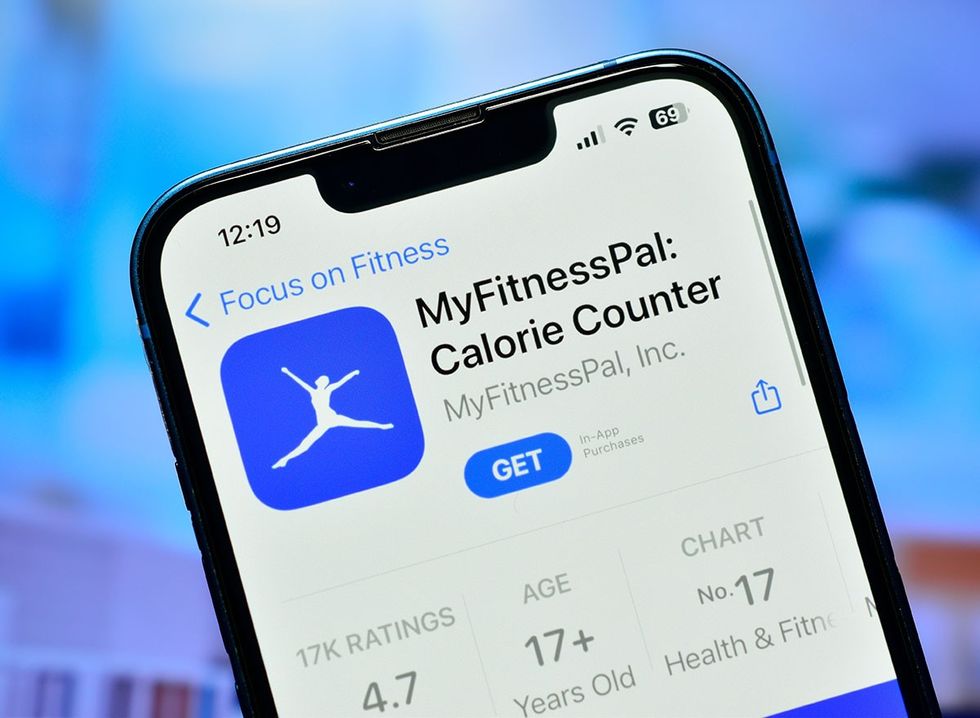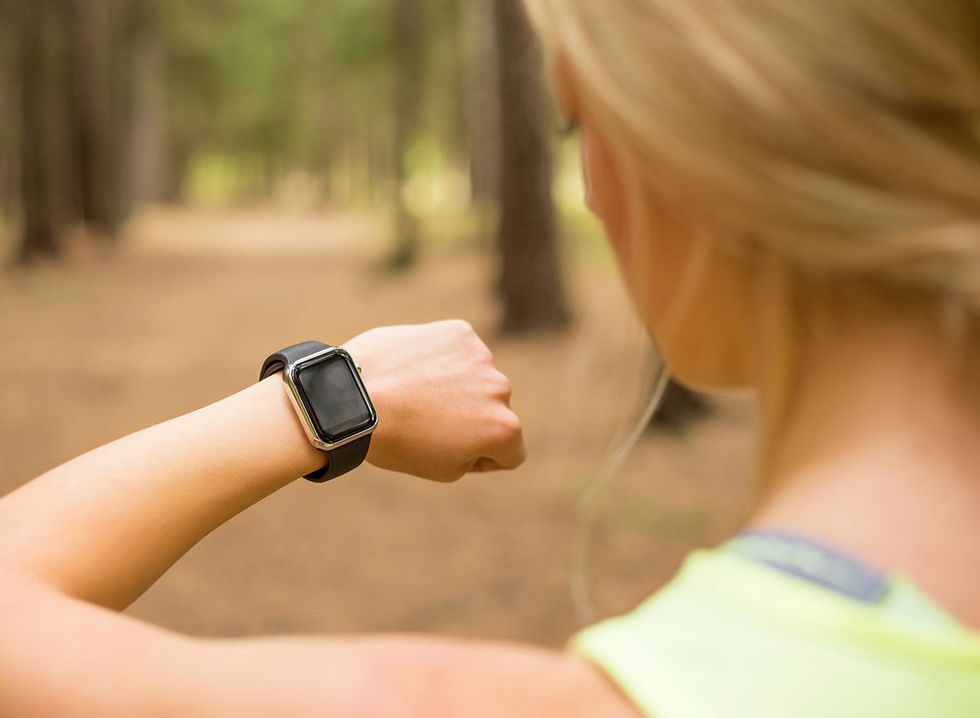Do you want to burn body fat without going on a drastic diet or spending hours in the gym daily? Paul Revelia, owner of Pro Physique, is a fitness coach who helps people burn fat and become the fittest versions of themselves. In one of his viral videos, he explains how walking was seriously instrumental in his own body fat loss journey and how you can follow in his footsteps. In the clip, he explains how “when I was trying to lose body fat,” all he did “was walk” and how 10,000 steps a day helped him achieve his goals.
Wear a Fitness Tracker

“Right here, we're gonna talk about the idea of fat loss and how it relates to getting steps per day. Because we now wear fitness trackers, we now have this accountability that we didn't have before, and it was a game changer for me when I actually started paying attention,” he explains in the video.
He Wanted to Determine How Many Steps Equals a Mile
He explains that he “ran an experiment at the local track” to figure out how many steps actually translate to one mile. He also wanted to figure out exactly what 10,000 steps “look like.”
10,000 Steps Is Generally Considered the Goal

He reveals that an FAQ is, “Can you please tell me if you can lose weight walking 10,000 steps?” But first of all, “what is 10,000 steps?” he asks. “I think a lot of us hear this term, you should get 10,000 steps a day, but what does 10,000 steps a day actually look like?”
He Tested It Out at His Local Track
So, he went to a local track that was a quarter mile. “Obviously, if it's a quarter mile, it takes four laps to walk a mile. So I decided I'm gonna run the time, and I'm gonna actually count my steps, not use a device. Sometimes, those are a little inaccurate. So, I actually walked multiple times around and counted my steps every time. So how many steps do you think it took to get around a quarter mile or a mile?”
One-Quarter Mile Took 5 Minutes and 440 Steps

“I was a little surprised,” he confesses. “That entire walk, which took five minutes to get around that quarter mile, took me 440 steps. Now I'm six foot three. Maybe my steps are longer than yours, but I was a little surprised. That means that it's only 1,760 steps for a mile. That means if you're getting 10,000 steps a day, what is that? Seven, eight miles? I mean, that is a significant amount of walking. And I think the idea of you losing weight walking 10,000 steps a day? Hell, yes.”
Walking and Walking for Fat Loss Are Two Different Things

He explained that he had used walking for all his fat loss in the past. “However, there is a big difference between walking and walking for the purposes of losing body fat,” Paul explains. “Now, when I'm traveling or going on vacation or I just wanna get my steps up so I can enjoy some food, I will do that. However, when I'm trying to get lean, when I'm trying to get shredded, get my body fat down, well below 10%, yes, I use walking.”
When Walking for Fat Loss, He Changes the Intensity

When he is walking for fat loss, “I'm not walking on a track at a casual pace. No, I changed the intensity of the exercise,” he says, revealing some “methods” to use walking for fat loss.
You Need to Calculate Calories In and Out and Your Metabolic Weight

First, you need to look at your “calories in, calories out,” he says. Next, you need to understand your “basal metabolic rate,” he adds. “What are your requirements? And then, how much are you burning throughout the day?”
Most of the Calories You Burn Aren’t From Exercise

“I think a lot of us assume that most of the calories we burn come in the form of exercise. That is actually a very small portion of that. In fact, I don't count my exercise towards my fat loss calories,” he reveals. “I only count what is typically gonna be my basal metabolic rate or the amount of energy that my body requires just to keep the lights on and keep moving along with the calories that I burn in cardiovascular exercise.”
He Lifts Weights

His focus at the gym is weightlifting. “When people say there's no way you got that physique just from walking, guys, I've been lifting weights for 30 years. The only thing that really changes when you see me here with a little bit more body fat and here with a little bit less body fat is the body fat. The muscle was there,” he says.
You Look More Muscular When You Shed Body Fat

“There's this weird thing that happens. You have this illusion. The more body fat you have, the more you don't have as much shape and detail. You actually look more muscular. More people come up to me in the gym when I'm 205 pounds than I'm at 235 pounds. This look is kind of an illusion. I'm not stronger. I don't have more muscle, and yet I look much more muscular, and I look stronger,” he says.
Diet Is Key

“That is what bodybuilding is all about. It's about dieting down, getting to very low body fat levels, and keeping as much muscle as possible. So, for the purposes of can you lose weight by walking 10,000 steps, yes. But you can also gain weight walking 10,000 steps a day if your diet is a mess,” he says.
RELATED: 4 Ways I Tightened My Sagging Skin After 50
He Recommends an Online Calculator

He recommends using an online calculator. “I'm gonna let you plug in all the information you need to get an accurate reading for where your calories should be for fat loss, rapid fat loss, muscle building, bulking, whatever it might be. And then you can give yourself a plan,” he says.
If You Overexercise, You Will Overconsume Calories

“Although I would love to just tell everyone, ‘Hey if you go walk 10,000 steps a day, you're gonna lose weight,’ what happens when some people exercise more, and the research actually backs this up, is they overconsume calories,” he says. “That's right. If you're not being accountable, well, there is a likelihood that you're going to eat more because you're hungrier. So this tells us that exercise might actually cause an induction of overeating.”
He Made This Mistake When He Was Younger

He even did that when he was younger and “got as fat as possible,” he admits. “I did end up putting on a lot of body fat through those years. I don't regret it because it was a learning experience, and I went through it. But I can also attest to the fact that sometimes, when you add more food, you actually move more, right? It's called adaptive thermogenesis. It works that way. Some people, they get more food, they get more energy. It all depends on where you're at in your life and your calories and your diet.”
You Can Walk on Incline, Change Intensity, and Change Speed

“Can you lose weight walking 10,000 steps a day?” He says the answer is yes. “That's seven miles or so of walking per day, which is a significant amount. Now, do I walk 10,000 steps? Perhaps, but what do I do? I change the intensity. I walk on an incline. I speed up on that incline.”
RELATED: I Lost 120 Pounds by Walking. Here Is What I Wish I Knew Before
Whatever Method You Choose, It Boils Down to Diet

“Is it better to walk 10,000 steps a day outside on a flat surface? Or is it better to walk 5,000 steps a day on an incline? Maybe it's better to walk 2000 steps, but you're sprinting, right? So, there are different modalities, intensities, and ways to get the same result. But ultimately, it all comes down to that big pie that shows us how many calories we're burning throughout the day, okay?” he says.
You Don’t Need to “Go Hard”

“Most of the calories that we're gonna burn are gonna come in the form of non-exercise activity. And a lot of the reasons I love using walking is because it's not a form of cardio that's gonna diminish my non-exercise activity. And this is what I mean by that. A lot of people love to go hard. They love to go hard on their cardio for 15 to 30 minutes, but then they're gas and exhausted the rest of the day. If you've ever done high-intensity sprints, you know what I'm talking about, it wrecks you. That means for the rest of the day, you have less neat or non-exercise activity thermogenesis. So, although you burn more calories in that 15 to 20 to 30-minute session, you burn fewer calories. The other 23 and a half hours a day. Who's the real winner here? Depends on your goals,” he says.
You Don’t Have to Be a “High-Intensity Athlete”

“If something specific requires you to be a high-intensity athlete, great. I’m not telling you guys 47 years old, lifetime natural, I'm sustaining well below 10% body fat with almost zero effort through walking, hitting my macros, and going to the gym a couple days a week,” he continues.
RELATED: I Got Into the Best Shape of My Life After 50 With These Top Foods
You Can Lose Weight Walking
“So yeah, get your butts to the track, count those steps. I wanna see if it's the same for you. Four me for a quarter mile. So what would that be? So that actually works out almost perfectly to six miles. It's about 10,000, 500 steps for six miles. So 10,000 steps is a six-mile walk. That is not nothing. You can definitely lose weight doing that,” he says. And if you enjoyed this article, don't miss 12-3-30 Walking Method: 20 Proven Tips to Lose Weight Faster.









 Shutterstock
Shutterstock Shutterstock
Shutterstock Shutterstock
Shutterstock Shutterstock
Shutterstock








 Shutterstock
Shutterstock Shutterstock
Shutterstock Shutterstock
Shutterstock Shutterstock
Shutterstock Shutterstock
Shutterstock Shutterstock
Shutterstock
 alexx.fitt/TikTok
alexx.fitt/TikTok alexx.fitt/TikTok
alexx.fitt/TikTok Shutterstock
Shutterstock Shutterstock
Shutterstock alexxandra.fitt/Instagram
alexxandra.fitt/Instagram Shutterstock
Shutterstock Shutterstock
Shutterstock



 I'm a Nutritionist and These 9 High-Protein Snacks Keep My Clients Full While Losing 50 Pounds
I'm a Nutritionist and These 9 High-Protein Snacks Keep My Clients Full While Losing 50 Pounds
 Shutterstock
Shutterstock 2. Processed FoodsShutterstock
2. Processed FoodsShutterstock Shutterstock
Shutterstock Shutterstock/Prostock-studio
Shutterstock/Prostock-studio Shutterstock
Shutterstock Pro TipsShutterstock
Pro TipsShutterstock Shutterstock
Shutterstock Shutterstock
Shutterstock Shutterstock
Shutterstock Shutterstock
Shutterstock Don’t Drink as Much AlcoholShutterstock
Don’t Drink as Much AlcoholShutterstock Most Women on GLP-1s Are Making a Few Common MistakesShutterstock
Most Women on GLP-1s Are Making a Few Common MistakesShutterstock Soda and Sugary DrinksShutterstock
Soda and Sugary DrinksShutterstock Shutterstock
Shutterstock Eat BreakfastShutterstock
Eat BreakfastShutterstock And Improve Insulin SensitivityShutterstock
And Improve Insulin SensitivityShutterstock Belly Flab Strip Tip: Sugar and Fat Calories Leave Its Mark on Your BodyShutterstock
Belly Flab Strip Tip: Sugar and Fat Calories Leave Its Mark on Your BodyShutterstock Shutterstock
Shutterstock The Drugs Mimic the GLP-1 Hormone Naturally Produced by the BodyShutterstock
The Drugs Mimic the GLP-1 Hormone Naturally Produced by the BodyShutterstock 3. Deep-Fried ItemsShutterstock
3. Deep-Fried ItemsShutterstock